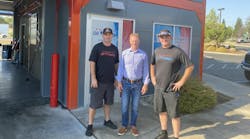To figure out where your shop is going, you have to know where you stand. Doing a certain amount of sales one year and then doing 50 percent better the next is a clear line, a clear improvement.
What if you started with more than one set of baseline numbers? It adds a whole new dimension to how a shop can judge its own data. Where a shop starts, how much it improves and how quickly is held up to another standard: That of other shops.
The competitive drive that comes from peer competition is a powerful force. And because market contenders typically won’t join forces and share numbers, 20 Groups formed outside of those boundaries.
NCM Associates operates 465 20 Groups in multiple automotive fields. One of those groups is one of the only quick lube 20 Groups around, and Brian Faulkenberry manages it.
An executive conference moderator, Faulkenberry says that the operators who succeed in the 20 Group are those who are driven by that competitive force.
“Most of them are A-type personalities. To me, that is a trait where second place isn't good enough,” he says. “They want to be a top performer, and they know that they can’t do it alone or in a vacuum. They recognize the value of the input from other operators who aren’t competitors of theirs— not in their market.”
Is your operation ready for a 20 Group? Study these four fundamental pillars of the 20 Group to find out.
Competitive Spirit
Those A-type personalities that Faulkenberry described is what drives the 20 Group. Knowing where others stand is a great way to benchmark a shop’s data, but it should also drive everyone who isn’t at the top of the heap toward that spot.
With that drive comes the reality that participation in the group is what leads to individual success.
“I think that’s probably their no. 1 trait is that they’re willing to learn from somebody else and they’re willing to implement those ideas and take a chance, if you will, of doing it maybe a way that's different from what they’ve done for however long,” he says.
Success in competition means having the right tools for the job. The four pillars of 20 Groups work together to create that toolkit.
Commitment
Operators in 20 Groups are committed to their craft, and they’re committed to making the groups work to their benefit. That takes an investment of money and time.
Faulkenberry’s 20 Group formed in 1996 when an AOCA member sought NCM’s help to form. It now has 13 members who meet three times per year. The members all travel to a location and hold a meeting to discuss numbers, processes and strategies. They eat together and hang out a bit before the trip is over.
The financial commitment can vary depending on how a group is set up, but Faulkenberry said that a starting estimate could be $10,000 per year to include all travel, dues, meals and other outings.
“It’s really a small investment for the opportunity that you have to improve your business and improve your bottom line,” Faulkenberry says.
Humility
Faulkenberry says that members employ a give-and-take mentality, and it’s a requirement to be a part of the 20 Group. In general, it means that the group works best when everyone participates, offers advice and accepts their own shortcomings to improve upon.
“You have to have some thick skin and an open mind at times,” he says. “Long as it’s done respectfully, then it will make you and the group better.”
One specific way that works is when a meeting takes place in a member’s hometown. Faulkenberry says that the whole group will take tours of a few facilities owned by the home operator. Each member has a standardized form to offer their criticisms and compliments on the operation.
That’s one of the huge benefits of the group, he says.
“The owner then has had the opp to have 10 to 15 veterans of the industry go through their operation and give them their honest appraisal and honest feedback,” he says. “If you try to put a dollar value on that to have some consultants come out and do it, that’s a lot of horsepower.”
The values of thick skin and participation are paramount in those times to really see improvement.
Data Sharing
A big part of the commitment of 20 Groups is internal data sharing.
Brian Faulkenberry, who manages a quick lube group, says that each member has a worksheet that is filled out and filed quarterly. It covers all the operational stats like car counts and services performed, as well as sales and cost figures.
Before each meeting, NCM compiles all the data and has it ready to review.
“We spend a fair amount of time every meeting going through that,” Faulkenberry says.
The numbers are broken out in different ways. Members see how they stack up against other members. They can see group averages, as well as an average of the top performers. Members discuss strategies for how those improvements are made.
That gives members what Faulkenberry calls the road map for improvement.
“In my opinion, it’s how you more than pay for your membership in the group,” he says. “You can lower your cost of goods or improve your gross margins or reduce your expenses. Those things all add up to additional profitability for your operation.”
Progression
A big part of the 20 Group isn’t just having that drive to improve and succeed. Members have to show it in the numbers.
By participating in data sharing and critiques, taking in good advice and making the necessary changes, Faulkenberry says the group has had a proven formula.
“The biggest one, usually, is cost of goods,” he says. “I’ve seen hundred-thousand-dollar improvements.”
In a way, progress is the result of the other three pillars, but it’s no less important. Members will question each other on their numbers, Faulkenberry says. They will be held accountable for lagging in one area or recognized for excelling in another.
That’s how the model drives individual success.
“Then everybody packs up their stuff, goes home and implements these things,” he says. “Makes these changes. Then we come back approximately four months later and go through the book again. And you can see who’s making progress.”





